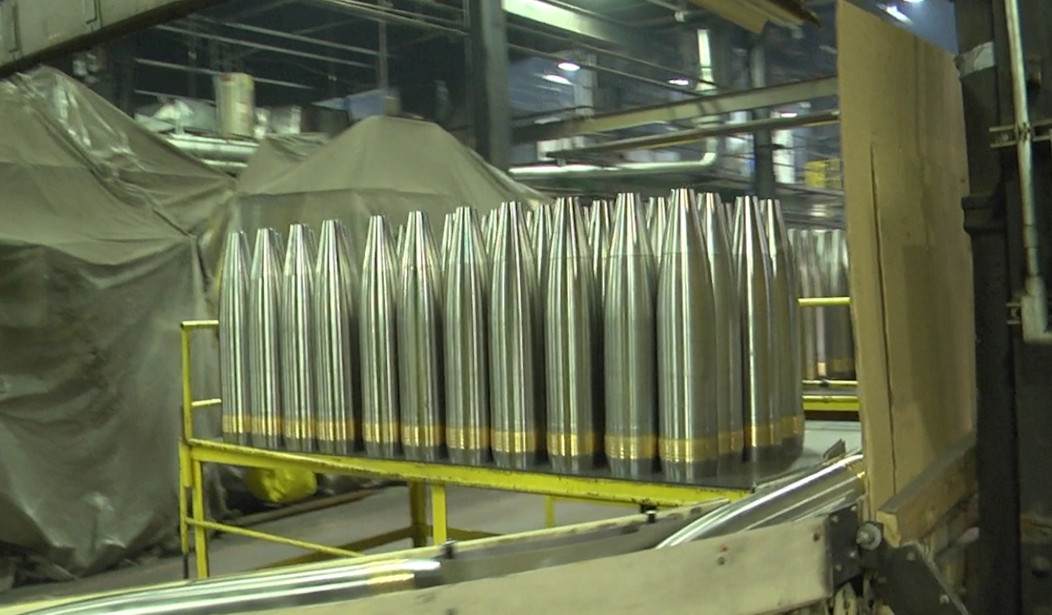U.S. defense aid to Ukraine is not only bolstering the defense of a friendly nation but also creating jobs for American workers and revitalizing the defense manufacturing base that has been in a death spiral since 1992. According to an exhaustive meta-analysis of Ukraine defense spending in the Washington Post, well over 90 percent of the military-related aid provided to Ukraine is spent domestically. The spending has resulted in the opening of new production lines, increased operations at existing facilities, and thousands of direct and indirect jobs created.
We have identified 117 production lines in at least 31 states and 71 cities where American workers are producing major weapons systems for Ukraine. For example, aid that Congress has already approved is going to, among many other places:
- Simi Valley, Calif.; Fullerton, Calif.; Andover, Mass.; Forest, Miss.; and York, Pa., to build Switchblade unmanned aerial systems, radar systems and tactical vehicles.
- York, Pa., and Anniston, Ala., to build Bradley infantry fighting vehicles.
- Aiken, S.C.; Elgin, Okla.; Sterling Heights, Mich.; Endicott, N.Y.; York, Pa.; and Minneapolis to build howitzers.
- Peoria, Ill.; Clearwater, Palm Bay and Niceville, Fla.; Camden, Ark.; Lancaster and Grand Prairie, Tex.; Rocket Center, W.Va.; and Trenton, N.J., to build HIMARS launchers.
- Anniston and Huntsville, Ala., and Camden, Ark., to build parts for the Hydra-70 rocket.
- Farmington, N.M.; Orlando; Tucson; and Troy, Ala., to build Javelin antitank missiles.
Many other weapons systems are being built for Ukraine in factories around our country. Nor does this list count the suppliers that provide these contractors with parts, such as plastic and computer chips, or produce smaller items for Ukraine, such as cold-weather and night-vision gear, medical supplies, spare parts and millions of rounds of small-arms ammunition.
The end of the Soviet Union resulted in a bacchanalia of Department of Defense cuts. Not only were the military services offered up as Bill Clinton's "Peace Dividend," but a round of "cost savings" under the Base Realignment and Closure Program savaged facilities that had little peacetime use but would be critical in wartime. One of the major targets was government-owned, government-operated (GOGO) and government-owned, contractor-operated (GOCO) factories that built munitions and military hardware. Even those facilities that survived found themselves deprived of money for modernization and partially mothballed. The ammunition plants operate very much like they did during World War II.
Many of the U.S. Army’s ammunition plants, arsenals and depots, mostly constructed in World War II, are time capsules of the era. The service has tried to update these wartime facilities, but there is much left to do to bring them into the 21st century.
McAlester Army Ammunition Plant in Oklahoma is dotted with shrub-cloaked ammunition bunkers built around 1943 and resembling Hobbit-holes. Old covered bridges that extend from external break rooms to manufacturing facilities across roads loom overhead but are now closed because of the presence of asbestos.
Since WWII, trains have carried in supplies and carted out ammunition in cargo containers. The Army has worked to update rail gauges and train cars to keep shipments moving on time, day and night.
Long, dark tunnels connect one facility for painting and prepping bomb shells to another where explosives are loaded into those rounds. A robotic arm spray-paints the outside of a shell in one facility.
But this automated capability isn’t available for the nuances of mixing explosives or filling shells, Brig. Gen. Gavin Gardner, commander of Joint Munitions Command, told Defense News on a tour of the ammunition plant’s production line for the Mark 82, a 500-pound bomb used by the Air Force. Operators still manually mix explosives — like tritonal, which is 80% TNT and 20% aluminum powder — using steam heated kettles, then adding it to the weapon mostly by hand.
That last sentence needs to be read carefully. The number of people alive who know how to steam-sweat tritonal and pour it into shell casings is in the low double digits. The number of those who are not Social Security recipients is a fraction of the total. With few facilities and limited production lines, providing a career path that would encourage someone to train for that job is very difficult.
Other vital production lines had been completely shuttered. The last FIM-92 Stinger Man-Portable Air Defense System (MANPADS) was produced in 2005. When Defense tried to restart production, they found the components for the missile were no longer produced, and the missile had to be redesigned.The manufacturer has been working with the US Defense Department on the issue, but “unfortunately, DoD hasn’t bought a Stinger in about 18 years, and some of the components are no longer commercially available,” he said.
Another underlying problem is that the machine tool component of the defense industrial base is so decrepit that when we went to expand production of 155mm shells, we found we did not have the machine tools to build equipment for new production lines.
Ironically, a significant number of the facilities and communities benefitting from the increased production of military items are in the districts of some of the most knee-jerk anti-Ukraine voices in Congress. Indeed, some of the public statements call into question the motives of the people making them.
This is Sen. J.D. Vance in October. By way of disclosure, I supported him in 2022.
The condition of the American defense industrial base is a national scandal. Repairing it is among our most urgent priorities. pic.twitter.com/BH4q7ZjS3d
— J.D. Vance (@JDVance1) October 10, 2023
Why he is concerned about Israel running short of ammunition and is willing to arm-twist Ukraine into giving up sovereignty and territory and can't see that Israel's demand for ammunition will never justify upgrading the defense industrial base is a mystery.
Then you get utter nonsense like this.
We asked for comments from the lawmakers who voted against aid that is going to their districts. “Manufacturing weapons in Ohio is good. You know what’s better? Using them for our own defense rather than sending them to a corrupt money pit in Eastern Europe,” Vance said. “There’s no question why Ukraine wants Abrams tanks … but our constituents have great concerns about seemingly unlimited taxpayer money being used to fund the war in Ukraine,” a spokesman for Jordan replied. “Alabama is right to be proud of our role in securing America’s national defense, but the United States cannot get involved in every conflict around the world,” said Tuberville. “We borrow $1 trillion every six months, and our growing national debt is our most dire national security threat,” said a spokesman for Braun. “I don’t vote for or against wars based on which congressional districts get the jobs,” Gaetz responded.
To call these responses moronic insults those hard-working, diligent morons who get up every morning to go out into the world to be morons.
First and foremost, we're not "involved" in a war. We are helping a country defend itself against open aggression. You have every right to be in favor of Russia's invasion; just don't try to pretend that you're doing anything but siding with Russia. Second, you can't say you are in favor of national defense or improving the defense industrial base and oppose the money used for that purpose via Ukraine defense assistance and refuse to deliver the same money for some other reason. I'll give Braun credit for consistency because, as far as I can tell, he's voted against every spending bill for quite a while. That said, consistency is, as they say, foolish hobgoblin of small minds, especially when the spending involves very small, relatively speaking, sums of money.
As we've seen from the Israel-Hamas War, it is impossible for any friendly nation to defend itself without our assistance. Just three weeks into the war, Israel was making emergency calls for ammunition and equipment. What the Ukraine War is showing us is that we cannot help Taiwan provide a credible defense against China. Worse, we don't have the capacity to provide the United States military with the ammunition or equipment they would need to prevail should we end up in a shooting war with China.













